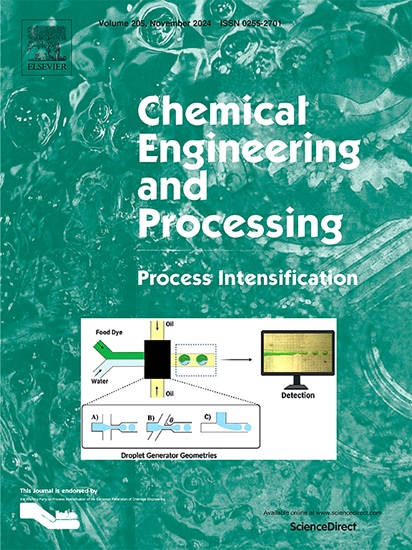微波辅助流化床反应器中甲烷热解制氢:催化流化床流体动力学和一维对流-分散模型
IF 3.8
3区 工程技术
Q3 ENERGY & FUELS
Chemical Engineering and Processing - Process Intensification
Pub Date : 2025-07-08
DOI:10.1016/j.cep.2025.110440
引用次数: 0
摘要
本文研究了Fe/C催化剂的最小流化速度(Umf),并给出了微波辅助流化床反应器(MAFBR)的初步模拟结果。通过实验和离散元法-计算流体动力学(DEM-CFD)建模方法对流体力学进行了研究。实验测定的Umf值与模型预测值吻合较好,模型简化为Fe/C催化剂颗粒呈球形。使用参考玻璃珠对模型进行进一步测试,强调了结合颗粒形状因素和颗粒大小分布对提高精度的重要性。当应用于两种不同玻璃珠组分的混合物时,该模型也显示出良好的性能。此外,利用轴向分散塞流模型进行了MAFBR建模,并结合了我们在之前的工作[1]中制定的Fe/C催化剂的CH4热解速率方程。该模型可以深入了解FBR在不同条件下的行为,包括温度、催化剂质量和甲烷流速。该方法为MAFBR的设计提供了依据。本文章由计算机程序翻译,如有差异,请以英文原文为准。

Towards hydrogen production by methane pyrolysis in a microwave-assisted fluidized bed reactor: Hydrodynamics of a catalytic fluidized bed and 1D convection-dispersion modelling
This study investigates the minimum fluidization velocity () of Fe/C catalyst and presents preliminary modelling results for a microwave-assisted fluidized bed reactor (MAFBR). The hydrodynamics was examined experimentally and through a Discrete Element Method-Computational Fluid Dynamics (DEM-CFD) modelling approach. A satisfactory agreement was observed between the experimentally determined and the value predicted by the model, which assumed a spherical shape for Fe/C catalyst particles as a simplification. Further testing of the model using reference glass beads highlighted the importance of incorporating particle shape factors and particle size distribution for improved accuracy. The model also demonstrated good performance when applied to a mixture of two different glass bead fractions. Additionally, MAFBR modelling was conducted using an axially dispersed plug flow model, incorporating a CH4 pyrolysis rate equation for the Fe/C catalyst formulated in our previous work [1]. The model provided insight into FBR behaviour under varying conditions including temperature, catalyst mass and methane flow rate. Such approach provides basis for the MAFBR design.
求助全文
通过发布文献求助,成功后即可免费获取论文全文。
去求助
来源期刊
CiteScore
7.80
自引率
9.30%
发文量
408
审稿时长
49 days
期刊介绍:
Chemical Engineering and Processing: Process Intensification is intended for practicing researchers in industry and academia, working in the field of Process Engineering and related to the subject of Process Intensification.Articles published in the Journal demonstrate how novel discoveries, developments and theories in the field of Process Engineering and in particular Process Intensification may be used for analysis and design of innovative equipment and processing methods with substantially improved sustainability, efficiency and environmental performance.

 求助内容:
求助内容: 应助结果提醒方式:
应助结果提醒方式:


